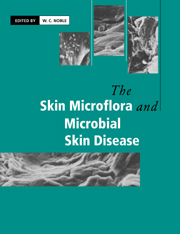Book contents
- Frontmatter
- Contents
- List of contributors
- Preface
- 1 The basis of the skin surface ecosystem
- 2 Nutrition of cutaneous resident microorganisms
- 3 Physical factors affecting the skin flora and skin disease
- 4 Coryneform bacteria
- 5 Coryneforms as pathogens
- 6 Staphylococci on the skin
- 7 Staphylococci as pathogens
- 8 Streptococci and the skin
- 9 Other cutaneous bacteria
- 10 Fungi and fungal infections of the skin
- 11 Bacterial and fungal skin disease in animals
- 12 Viral skin disease in man
- 13 Viral skin disease in animals
- 14 Microbial interactions on skin
- 15 Adherence of skin microorganisms and the development of skin flora from birth
- 16 Skin disinfection
- Index
2 - Nutrition of cutaneous resident microorganisms
Published online by Cambridge University Press: 04 December 2009
- Frontmatter
- Contents
- List of contributors
- Preface
- 1 The basis of the skin surface ecosystem
- 2 Nutrition of cutaneous resident microorganisms
- 3 Physical factors affecting the skin flora and skin disease
- 4 Coryneform bacteria
- 5 Coryneforms as pathogens
- 6 Staphylococci on the skin
- 7 Staphylococci as pathogens
- 8 Streptococci and the skin
- 9 Other cutaneous bacteria
- 10 Fungi and fungal infections of the skin
- 11 Bacterial and fungal skin disease in animals
- 12 Viral skin disease in man
- 13 Viral skin disease in animals
- 14 Microbial interactions on skin
- 15 Adherence of skin microorganisms and the development of skin flora from birth
- 16 Skin disinfection
- Index
Summary
Introduction
Investigators concerned with the nutrition of microorganisms usually start their research with the question, ‘What chemicals does this microorganism require to grow?’ Perhaps a better question would be, ‘What chemicals does this microorganism utilize in its environment?’ To obtain formal proof of the nutrition of cutaneous microorganisms in the skin environment has been an impossibility for many reasons. There is the ethical problem of obtaining samples of both the cutaneous populations and human skin. Experiments on laboratory animals, although offering some hope, are severely limited because the skin microflora is different from that of man. For example, there are no propionibacteria or Malassezia furfur on animal skin, yet these microorganisms are widely distributed over human skin. Also, and related, are the different macromorphological structures of animal and human skin. Animal skin is haired and lacks the sebaceous gland systems with large follicles and small vellus hairs. Even those animals bred hairless have skin that is distinctly different from human skin. Another complication is that the sampling of the skin environment and the subsequent chemical and biochemical analyses of presumptive nutrients can be misleading. The molecules used as nutrients by the resident microflora may well not be present in the sample because they have been used to exhaustion; some of the molecules in the sample may well be end-products of metabolism of the microbial population, for example acetate and propionate from Propionibacterium acnes fermentation.
- Type
- Chapter
- Information
- The Skin Microflora and Microbial Skin Disease , pp. 33 - 72Publisher: Cambridge University PressPrint publication year: 1993
- 9
- Cited by



